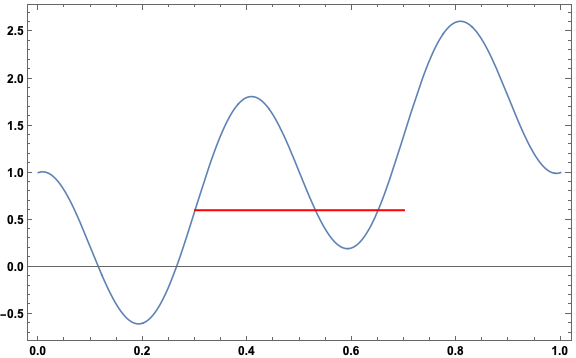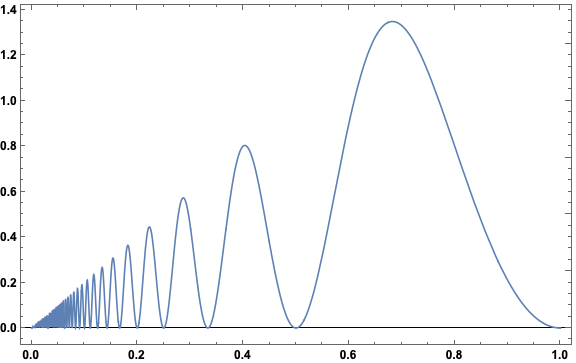The problem
Consider a function (f: [0, 1] \to \mathbb{R}) that is continuous with (f(0) = f(1)). It is possible to prove that for each (n \in \mathbb{N}), there exist (x_n, y_n \in [0, 1]) such that (|x_n - y_n| = 1/n) and (f(x_n) = f(y_n)). This means the set of points at which the function is not one-to-one is at least countably infinite. Providing the proof is part of Exercise 4.5.6 in Abbott’s Understanding Analysis (2nd edition).
I’m not going to discuss the proof here, but I am interested in the final part of the exercise, which asks for a specific counterexample. Quoting Abbott:
If (h \in (0, 1)) is not of the form (1/n), there does not necessarily exist (|x - y| = h) satisfying (f(x) = f(y)). Provide an example that illustrates this using (h = 2/5).
I found this perhaps harder than it should have been. Restating the problem slightly, we are looking for a function (f) such that (f(x + 2/5) - f(x) \neq 0), for all (x \in [0, 3/5]) (since (3/5 = 1 - 2/5)), while satisfying the requirement that (f(0) = f(1)).
A specific counterexample
After some trial and error, I hit on the idea of using a function that does have a period of (2/5), and then modifying it somehow. Starting with (\sin): [ \sin\left(\frac{5}{2}2\pi x\right) ] has a period of (2/5), since [ \sin\left[\frac{5}{2}2\pi \left(x + \frac{2}{5}\right)\right] = \sin\left(\frac{5}{2} 2\pi x + 2 \pi\right) = \sin\left(\frac{5}{2}2 \pi x\right). ]
Now for the desired function (f), try a function of the form [ f(x) = \sin\left(\frac{5}{2}2\pi x\right) + a x .] Requiring that (f(0) = f(1)) means that [a = - \sin\left(\frac{5}{2}2\pi\right) = 0,] so this functional form won’t work.
Instead of (\sin), lets try (\cos): [ \cos\left(\frac{5}{2}2\pi x\right) ] has a period of (2/5), and trying the same kind of functional form: [f(x) = \cos\left(\frac{5}{2}2\pi x\right) + a x ], we see that (f(0) = 1) and (f(1) = -1 + a), so (a = 2) works. Calculating the difference [ f(x + \frac{2}{5}) - f(x) = 2 \left(x + \frac{2}{5}\right) - 2x = \frac{4}{5}, ] so this is the desired counterexample! Here is a plot, along with a horizontal red line of length (2/5) shown at one point along the function:

Imagine sliding the red line around on the function (keeping it horizontal). The two ends of the line never simultaneously interesect the function! In fact, a little experimentation shows that the line is not optimal, in the sense that it could be a bit shorter or a bit longer and still not intersect the function at both ends. So our counterexample (f(x)) is a counterexample for values of (h) close to (2/5) as well as for (h = 2/5).
Generalizing
The fact that the above function (f(x)) is a counterexample for values of (h) close to (2/5) shows that there is nothing special about (2/5). Specifically there is nothing special about the fact that it is rational. So let’s try to find a function for arbitrary values of (h \in (0, 1)).
First, note that we can take care of many values of (h) at once by using the simple function [f(x) = \sin(2\pi x). ] If (h > 1/2) and (x < 1/2) then (f(x + h) = -f(x)), so (f(x + h) - f(x) = -2 f(x) < 0). We don’t have to consider larger values of (x) since the property (f(x + h) \neq f(x)) only needs to hold for (x \in [0, 1 - h]). This shows that there does not necessarily exist (h \in (1/2, 1)).
For arbitrary (h \in (0, 1/2)), let’s try a function of the same form as the specific counterexample above: [ f(x) = \cos\left(\frac{2\pi x}{h}\right) + a x.] Then (f(0) = 1 ) and (f(1) = \cos\left(\frac{1}{h}2\pi\right) + a), so the desired form is [ \boxed{ f(x) = \cos\left(\frac{2\pi x}{h}\right) + \left(1 - \cos\left(\frac{2\pi}{h}\right)\right)x .} ]
Calculating the difference: [ f(x + h) - f(x) = h \left(1 - \cos\left(\frac{2\pi}{h}\right)\right) = 2 h \sin^2\left(\frac{\pi}{h}\right),] using a half-angle formula.
The difference is greater than zero for all values of (h) except for (h) such that (\sin(\pi/h) = 0), which are exactly the values (1/n, n \in \mathbb{N}) for which there is always at least one place where the function is not one-to-one!
Here is a plot of the difference (f(x + h) - f(x) = 2 h \sin^2\left(\frac{\pi}{h}\right) ) as a function of (h):

It only intersects zero at the countably infinite set of points (1/n, n \in \mathbb{N}).
Summary
Any continuous function (f:[0, 1] \to \mathbb{R}) satisfying (f(0) = f(1)) must fail to be one-to-one for at least one pair of points in ([0, 1]) separated by (h = 1/n), and this is true for all (n \in \mathbb{N}). Furthermore, by the counterexample given above, there are no other “separations” (h \in (0, 1)) for which non-injectivity is guaranteed!
Is there another general functional form that provides a counterexample for arbitrary values of (h \neq 1/n)? Let me know if you find one!